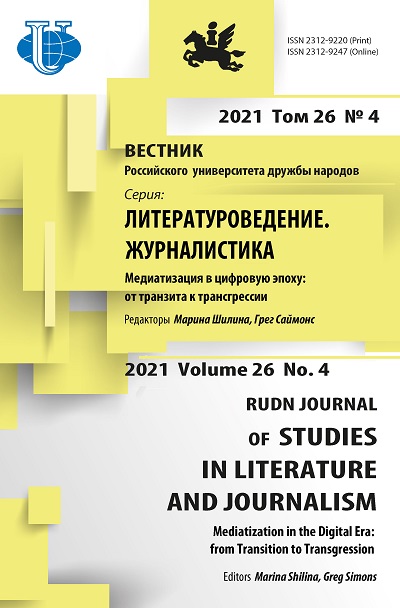Immersive Technologies in Media: Towards the Concept of Generative Mediatization?
- Authors: Shilina M.G.1, Wirth J.2
-
Affiliations:
- Plekhanov Russian University of Economics
- University of Applied Sciences and Arts Western Switzerland
- Issue: Vol 26, No 4 (2021): MEDIATIZATION IN THE DIGITAL ERA: FROM TRANSITION TO TRANSGRESSION
- Pages: 672-680
- Section: JOURNALISM
- URL: https://journals.rudn.ru/literary-criticism/article/view/29858
- DOI: https://doi.org/10.22363/2312-9220-2021-26-4-672-680
- ID: 29858
Cite item
Full Text
Abstract
The practices of so-called immersive media have been developing in the past few years. The immersive media situation characteristics, infrastructure, content and social aspects have been identified through the use of a multilevel structural and functional methodology, and make it possible to fix its specificity at all levels. The new format of the immersive media situation leads to changes in approaches to the mediatization studies. In the article, to study the media immersive communicative situation a generative approach is proposed for the first time. It is relevant to topological thinking, and to the modern immanent picture of the world, when a person and technology co-create a new form. Along with the generative approach and generative design, the necessity of applying relevant paradigms and methods of psychology to form new theoretical and methodological foundations of immersive user-centric media communication is substantiated. Several new concepts and terms are introduced, in particular, the term “immersive hypermediation”, which is opposite to immediacy as a classical criterion of media effectiveness. As a result, the analysis of the essence and features of immersive media projects allows fixing the premises of immersive paradigm shift in mediatization studies.
About the authors
Marina G. Shilina
Plekhanov Russian University of Economics
Author for correspondence.
Email: marina.shilina@gmail.com
ORCID iD: 0000-0002-9608-352X
Professor
36 Stremyanny Ln, Moscow, 115093, Russian FederationJulia Wirth
University of Applied Sciences and Arts Western Switzerland
Email: Julia.wirth@he-arc.ch
ORCID iD: 0000-0002-1006-9349
Associate Professor, Haute ecole de gestion Arc
21 Espace de l’Europe, Neuchâtel, 2000, SwitzerlandReferences
- Volkova, I.I. (2014). Game formats of multimedia journalism. RUDN Journal of Studies in Literature and Journalism, (1), 105-112. (In Russ.)
- Friedman, D., & Kotzen, C. (2018). Immersive Journalism: The New Narratives / Robot Journalism: Human Journalism Survive? (pp. 79-91).
- Ferjoux, C., & Dupont, R.E. (2020). Journalisme immersif et empathie: l’émotion comme connaissance immédiate du réel. Communiquer. Retrieved May 25, 2021, from 10.4000/communiquer.5477' target='_blank'>http://journals.openedition.org/communiquer/5477;doi: 10.4000/communiquer.5477
- Shilina, M.G. (2012). Textogenic Transformation of the Infosphere. A methodological Sketch of the Internet Growth. Moscow. (In Russ.)
- Grau, O. (2013). Emotion and Immersion: Key Elements of Visual Research. Saint Petersburg: Eidos. (In Russ.)
- Deryughina, O. Immersive and Interactive Environments. Retrieved May 25, 2021, from https://redmuseum.church/deryugina-environments (In Russ.)
- Negroponte, N. (1970). The Architecture Machine. Cambridge, MIT Press.
- Kolomiets, V.P. (2019). Conceptualization of media communication. MediaScope, (4). Retrieved May 25, 2021, from: http://www.mediascope.ru/2575 doi: 10.30547/media scope.4.2019.2 (In Russ.)
- Flavián, C., Ibáñez-Sánchez, S., & Orús, C. (2019). The impact of virtual, augmented and mixed reality technologies on the customer experience. Journal of Business Research, (100), 547-560. doi: 10.1016/j.jbusres.2018.10.050
- Novikova, A.A., & Kiriya I.V. (2018). Aesthetics of immersiveness: Features of creativity of a journalist in multimedia and transmedia projects. Bulletin of St. Petersburg University. Language and Literature, 15(2), 276-288. doi: 10.21638/11701/spbu09.2018.210 (In Russ.)
- Livingston, S. (2008). Mediatization of Everything.
- O’Sullivan, P.B., & Carr, C.T. (2018). Masspersonal Communication: A Model Bridging the Mass-Interpersonal Divide. New Media & Society, 20(3), 1161-1180. doi: 10.1177/1461444816686104
- Artamonova, Y.D., & Volodenkov, S.V. (2021) Mediatization as a research concept: Main prerequisites, the formation and possibilities for further development. Praema. Journal of Visual Semiotics, (2), 9-27. (In Russ.)
Supplementary files















